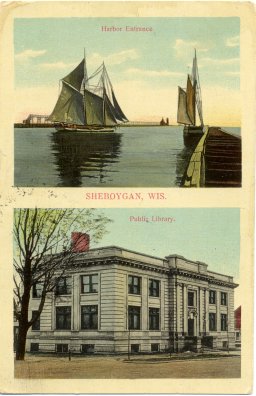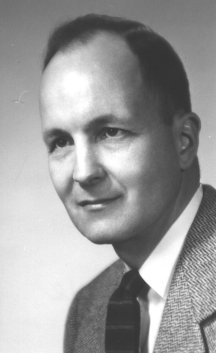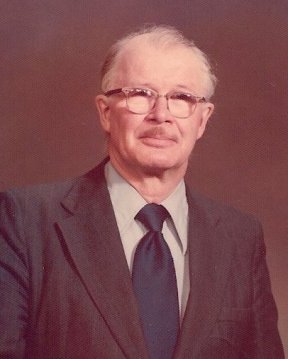
For me attending a conference of the Wisconsin Association of Public Libraries (WAPL), a division of the Wisconsin Library Association (WLA) is like walking into a bar called Cheers. There are lots of longtime friends and “everybody knows your name”. These days my name is mostly associated with library history, and that was why I was in Sheboygan, Wisconsin on Thursday and Friday of this week. At a conference with the theme “Anchoring the Past, Setting Sail for the Future”, I was there to help anchor the past with a program which I called “Turning Your Library’s History into a Public Relations Asset”. The conference was held at the Blue Harbor Resort, the anchor to a major harbor development, right on beautiful Lake Michigan. Dick Nelson, the conference program chair, had to twist my arm a little to get me to do the program. Not that I would actually pass up on an opportunity to promote library history, but when competing with five other programs in the same time slot I wasn’t optimistic about the size of the audience I would be talking to. With past programs about library history I have sometimes ended up talking to a very small choir of like minded individuals. In this instance, that turned out not to be the case. The size of my audience was a respectable percentage of the 300 plus conference attendees.
In any case to hedge my bets and to ensure that the preparation for my presentation was not wasted, I had taken this opportunity to enhance the website of the Wisconsin Library Heritage Center (WLHC) by creating three new web pages. One of my responsibilities as Chair of the Steering Committee for the WLHC is maintaining the website. This also enabled me to avoid using technology onsite in my presentation (something I hate), and enabled the audience to avoid taking copious notes on my words of wisdom. This approach also allows those of you reading this post to benefit from the presentation without being there. Since a library has to have researched and compiled some form of a library history in order to turn it into a public relations asset, the first web page supporting my presentation deals with Researching and Writing a Library History. I want to acknowledge ALA’s Library History Round Table, Bernadette Lear, and other members of the WLHC Steering Committee for much of the content on this web page. The second web page is about the core message of the program “Marketing Library History”, and the final web page is focused on “Celebrating Anniversaries”.
Attending the WAPL Conference was a great opportunity to talk to old and new friends. The reception on Thursday night at the Mead Public Library was a wonderful event. The library’s outstanding facility includes many interesting spaces and artifacts. Among them is a portrait of Andrew Carnegie from their old Carnegie facility (shown on the postcard above). I’m hoping to take advantage of some of their display cases for an exhibit later in the year. While in Sheboygan I also picked up a vintage public library book box which WAPL Conference Chair David Weinhold had assisted me in obtaining via Craigslist. On the way home I swung up to Menasha to pick up a library history exhibit featuring the Tabard Inn Library, the Booklovers Library, and Wisconsin Library Memorabilia. All in all a great couple of days for a library history buff.



 H. Vail Deale was inducted into the Wisconsin Library Hall of Fame on November 4, 2010 at the Wisconsin Library Association Conference in Wisconsin Dells. Deale served as Director of Libraries and Chair, Department of Library Science at Beloit College from to 1953 to 1980. A highlight of his career at Beloit was the planning and completion of the Colonel Robert H. Morse Library in 1962 which resulted in the library being designated as WLA’s 1962 Library of the Year, the first academic library to receive this honor. Deale was a member of the 1954-55 Steering Committee that helped establish the Wisconsin Association of Academic Libraries in the Wisconsin Library Association and served as its first chair in 1955-56. Deale served as President of the Wisconsin Library Association in 1960-61. He served a six year term on the Governor’s Council on Library Development. He was a life member of the American Library Association and served as chair of the ALA International Relations Committee (1957-77); chair of the ACRL College Section (1961-62); chair of the ACRL Grants Committee (1967-70); and a member of the ACRL Standards Committee.
H. Vail Deale was inducted into the Wisconsin Library Hall of Fame on November 4, 2010 at the Wisconsin Library Association Conference in Wisconsin Dells. Deale served as Director of Libraries and Chair, Department of Library Science at Beloit College from to 1953 to 1980. A highlight of his career at Beloit was the planning and completion of the Colonel Robert H. Morse Library in 1962 which resulted in the library being designated as WLA’s 1962 Library of the Year, the first academic library to receive this honor. Deale was a member of the 1954-55 Steering Committee that helped establish the Wisconsin Association of Academic Libraries in the Wisconsin Library Association and served as its first chair in 1955-56. Deale served as President of the Wisconsin Library Association in 1960-61. He served a six year term on the Governor’s Council on Library Development. He was a life member of the American Library Association and served as chair of the ALA International Relations Committee (1957-77); chair of the ACRL College Section (1961-62); chair of the ACRL Grants Committee (1967-70); and a member of the ACRL Standards Committee. Wayne Bassett was inducted into the Wisconsin Library Hall of Fame on November 4, 2010 at the Wisconsin Library Association Conference in Wisconsin Dells. He served as Director of the Wausau Public Library from 1965 to 1974. When the Wausau Public Library merged with the Marathon County Library in 1974 to become the Marathon County Public Library, he served as Director of the merged library until his retirement in 1983. Concurrently (1965-1983), he served as the Director of what is now the Wisconsin Valley Library Service. Serving as the Wisconsin Library Association’s first Legislative Advocate from 1971 to 1979 he played an important role in the enactment of Wisconsin’s public library system law. Bassett received WLA’s Special Service Award in 1971 and served as President of WLA in 1976. He was named WLA’s Librarian of the Year in 1979. His life and service to the Wisconsin library community were recognized with a WLA Special Memorial Citation in 1988.
Wayne Bassett was inducted into the Wisconsin Library Hall of Fame on November 4, 2010 at the Wisconsin Library Association Conference in Wisconsin Dells. He served as Director of the Wausau Public Library from 1965 to 1974. When the Wausau Public Library merged with the Marathon County Library in 1974 to become the Marathon County Public Library, he served as Director of the merged library until his retirement in 1983. Concurrently (1965-1983), he served as the Director of what is now the Wisconsin Valley Library Service. Serving as the Wisconsin Library Association’s first Legislative Advocate from 1971 to 1979 he played an important role in the enactment of Wisconsin’s public library system law. Bassett received WLA’s Special Service Award in 1971 and served as President of WLA in 1976. He was named WLA’s Librarian of the Year in 1979. His life and service to the Wisconsin library community were recognized with a WLA Special Memorial Citation in 1988.










